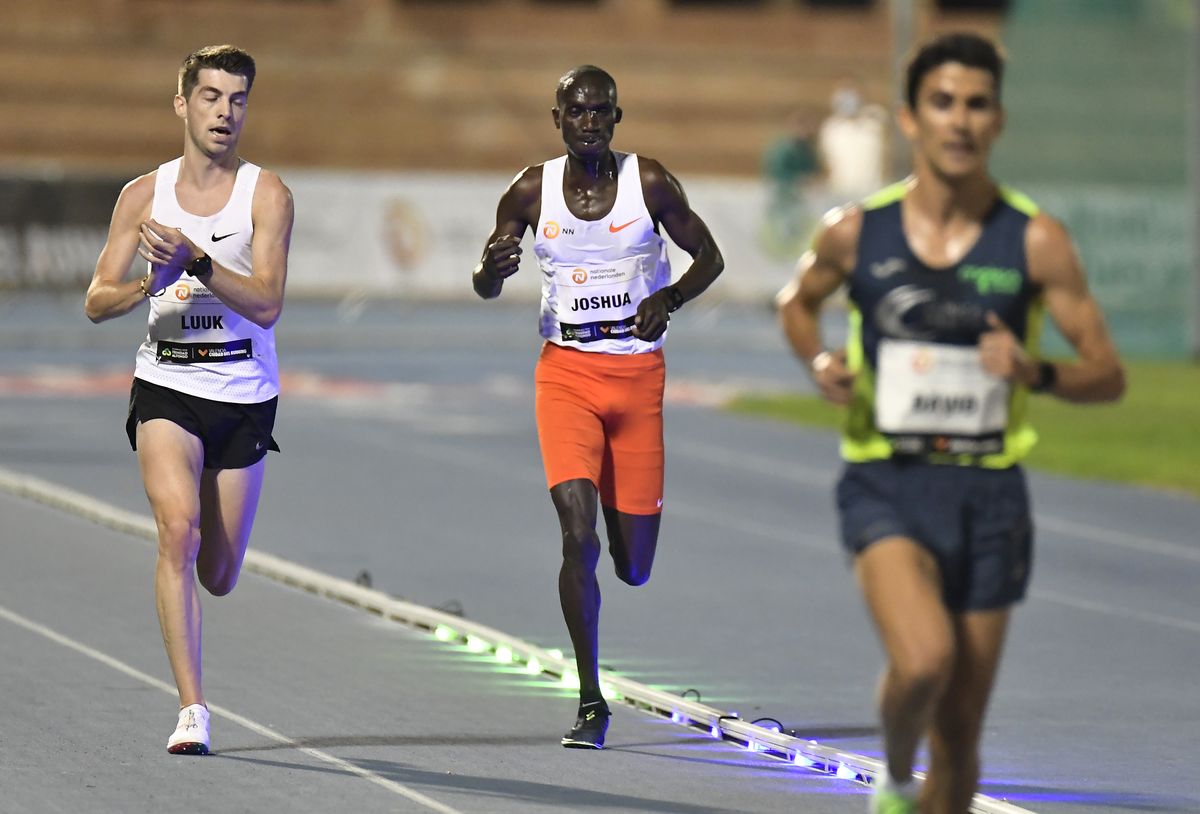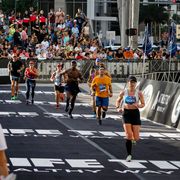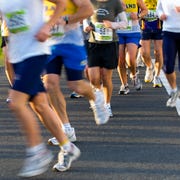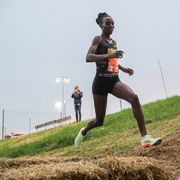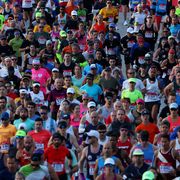The familiar horn sounds, and your heart skips a beat as your feet cross the timing mat. It’s the start of your goal race, and after countless hours toiled on the roads and track, the success or failure of your run now rests solely on your ability to execute the perfect race strategy.
The line between setting a new personal best and a near miss is razor thin, especially if you’re an experienced runner with an impressive training log and lofty goals. Running just a few seconds too fast or too slow at any point in your race could change the primary energy system your body is utilizing and spell disaster for a personal record attempt. To make the task more difficult, your sense of pace and effort get thrown off as adrenaline rushes through your body and the roar of the crowd alters your senses.
Experienced runners are well aware of the physiological and mental training required to reach their potential, but how much thought and effort is given to the importance of pacing? How do you determine what the optimal strategy is for each race distance that you may run? More importantly, how do you develop a subconscious sense of pace so subtle that you can recognize a few seconds’ difference per mile?
The importance of pacing
Nearly every world record, from the 1500 meters to the marathon, has been set by an athlete running negative splits. In fact, according to research by South African sport scientists Tim Noakes, Ross Tucker, and Mike Lambert, in the history of runs that set new world records at 5,000 meters and 10,000 meters, only once has any kilometer other than the first or last been the fastest of the race.
Analyzing the greatest performances in history at events from the 5K to the marathon reveals another statistic about the importance of pacing—specifically, how fine the line is between too fast and too slow.
Consider Haile Gebrselassie’s world-record attempts at Berlin in 2008, where he became the first person to run under 2:04 for the marathon, and Dubai in 2009, where he faded badly in the last 10K. In Dubai, Gebrselassie was a mere 23 seconds faster at halfway than his world-record pace in Berlin the year before; however, even this small shift in pace (about 1 second per kilometer) resulted in a crash that left him running 90 seconds slower than Berlin over the final 10K.
Optimal pace strategies for your race distance
“We’ve got decades of the best runners trying to squeeze out every ounce they can to improve records, so it makes sense that their pacing strategies would be near optimal,” says Steve Magness, physiologist and University of Houston head cross-country coach. By blending empirical data from world-record performances with scientific research conducted on pacing tactics and the physiological demands of racing, we can extrapolate the “optimal” pacing strategy for each race distance.
5K and 10K
A recent study in the Journal of Strength and Conditioning Research demonstrated that in order to optimize 5K performance, runners should start the first mile of a 5K race at paces 3 to 6 percent faster than their goal race pace. When test subjects ran 3 to 6 percent faster the first mile, settled in to goal pace for the middle miles, and kicked the last 800 meters, their finishing times were, on average, 29 seconds faster than those runners who started slower than, or at, goal race pace.
So the plan at your next 5K should be to blast the first mile as fast as you can and hold on, right? Not so fast. The researchers found that running the first mile more than 6 percent faster than goal race pace considerably reduces performance, so much so that almost all the subjects who started this fast failed to even finish the race.
This scientific data coincides with Noakes, Tucker, and Lambert’s observations of world-record performances, where they saw the first kilometer run about 3 to 4 percent faster than goal race pace and a strong final kilometer finish.
10-Mile and Half Marathon
From an energy-use perspective, we know that races of this distance should be run at or slightly above your lactate threshold pace. Running faster than your lactate threshold creates a situation where the aerobic system is unable to keep up with removing waste products that cause muscle fatigue that are being generated by anaerobic energy production. Consequently, it’s important that runners run slightly slower than this threshold for as long as possible, particularly at the start of the race, to prevent waste products from building and causing fatigue during the early miles.
From a psychological perspective, it’s also important to hold back a little at the start of a race. As Magness explains, “If we use the Central Governor Model [the concept that the mind controls the experience of fatigue], we want to get to the last quarter of the race as fast as we can, while still feeling good enough to have the body say, ‘Hey, we’re okay—loosen the reins a little,’ so that we can have a kick.” To do so, runners must start the first mile or two of a race slightly slower (5–15 seconds/mile) than goal pace to ensure they have the psychological resources in reserve to finish strong.
Marathon
Many marathoners are familiar with the term “putting time in the bank,” which is a simple way of describing the strategy of running the first half of the race faster than goal pace to compensate for the time you’ll lose on the second half. Unfortunately, this racing strategy couldn’t be more wrong, both from the perspective of physiology and from what empirical evidence shows us.
World-record attempts are great examples to show how a negative-split strategy is optimal when seeking PRs. We can also look at other elite performances on challenging courses—the type you might be facing if not running a pancake-flat course like Berlin.
For example, let’s consider the men’s and women’s top runners at the 2011 New York City Marathon. Mary Keitany’ goal on race day was to win the race and set a course record. The course record at NYC is 2:22:31, and Keitany scorched the first 13 miles in 1:07:56. Even at 15 and 16 miles, Keitany was still more than 6 minutes faster than record pace, and she had what seemed an insurmountable 2:24 lead on the next pack of women. Over the final few miles, Keitany fought hard and ran tough, but she eventually finished third with a time of 2:23:38, more than a minute over the course record and 8 minutes slower than projected at 16 miles.
The men’s race in 2011 was quite the opposite. The men raced in a tight pack of 10 runners through halfway, reaching the 13.1-mile marker in 63:17—a 4:49/mile pace and just under the old course-record pace. The pace remained “gentle” until 20 miles, when a pack of seven runners ripped off a couple of 4:30 mile splits. At mile 24, eventual winner Geoffrey Mutai broke away and crushed the previous course record by finishing in 2:05:06, averaging 4:40/mile for the last 10K and 4:47 for the race.
When it comes to how your body works, the main issue with the “time in the bank” strategy concerns the use of fuel—specifically, whether you burn glycogen or fat. As anyone who’s hit the wall knows, one of the limiting factors in marathon performance is how efficiently you can burn fat instead of carbohydrates for energy. Once you burn through your available carbohydrate stores, your performance will suffer, most notably from “bonking” or running out of fuel.
Unfortunately, the faster you run, the greater the percentage of fuel and energy that comes from carbohydrates. Therefore, by starting faster than goal pace and putting “time in the bank,” you’re actually burning through your available carbohydrate stores faster, and you will almost certainly run out of fuel and crash.
One approach to marathon pacing is to run the first half of the marathon 2 to 3 percent faster than goal pace, based on the theory that your muscles become less economical as they fatigue, slowing your lactate-threshold pace and resulting in a slightly positive marathon split for the second half, even if you avoid running out of glycogen.
This approach to the marathon race does have its merits, and is subscribed to by coaches as knowledgeable as Pete Pfitzinger. Based on my coaching experience with marathoners in the 2:30–3:45 range, however, I find that they usually have developed a strong ability to resist fatigue, thanks to moderate mileage and a reliance on 20- to 23-mile long runs. Therefore, I believe that glycogen becomes more of an issue for runners in this pace and ability range. The average marathon pace of a well-trained runner should be right at their aerobic threshold, the point at which fat can still be used efficiently as an energy source. When runners go over their aerobic threshold, even by a few seconds, they burn more glycogen and are more likely to hit the wall.
Consequently, I believe the ideal marathon pacing strategy is to run your first 3 to 5 miles at slower than goal pace to conserve energy, maintain goal marathon pace through 20–22 miles, and then run your fastest over the last 8K to 10K.
Developing a sense of pace in training
Many runners are not particularly good at pacing. A study published by the European Journal of Applied Physiology found that recreational runners misjudged their pacing efforts by almost 40 seconds per mile compared to experienced college runners, who were only off by about 10 seconds per mile.
If pacing is something you need to work at, how do you separate yourself from the pack and train to pace yourself like clockwork? Particularly, where does pace training fit into a schedule already packed with threshold workouts, long runs and VO2 max sessions?
Perhaps the most efficient way to teach yourself how to find and lock in to an appropriate pace is to learn to monitor your body signals. “I think learning to run by feel is incredibly important and something I work on in every workout,” says 2:11 marathoner Nick Arciniaga. “If an athlete can learn how they are supposed to feel at any given pace, then it’s easier to know if they are too fast or too slow during a race and adjust.”
The first step is learning to listen to your body. Nate Jenkins, a 2:14 marathoner, suggests monitoring your breathing to quickly identify changes in effort level. Especially at threshold paces, small changes in speed can make your breathing feel stressed and ragged, or cause you to modify your breathing rhythm in relation to your stride rate. “Once you lock on to your correct goal pace for the workout, cover up the Garmin and listen to your breathing, feel the rhythm in your legs, and notice the motion of your arms. If you start to breathe slower or faster, check your pace to see how this breathing change correlates with your speed,” Jenkins says.
You can also integrate specific workouts into your schedule that will help you feel small variants in pace. Two workouts, the cutdown run and the alternating tempo, are particularly effective. Both of these workouts require you to continually adjust your pace by as little as 10 seconds per mile, which enables you to identify the difference in how your body feels with just a small change in pace. Plus, they are great threshold and lactate clearance workouts, so they won’t distract from your physiological training goals.
Workouts to improve your pacing
Carl Foster, an exercise scientist at the University of Wisconsin-La Crosse and one of the world’s leading experts on pacing, says, “Given the various tactics in running and other head-to-head type competitions, I suspect that the learning curve requires three to four attempts at a specific pace before proficiency can be expected.” Therefore, scheduling one or two workouts in each of the last few weeks of your training schedule will help you become a master at your goal pace just as race day approaches. Here are two to try:
Cutdown workouts train your body to increase effort over time, preparing you for how a pace will feel different during the first and last mile of a race. Cutdown runs can be between 5 and 10 miles, depending on your normal workout volume. Start the workout at 20-30 seconds slower than marathon pace and drop 10 seconds per mile, until you are running just a bit faster than half marathon pace.
For a 3:30 marathoner, a cutdown workout might look something like this: 2-mile warmup, 6-mile cutdown (8:20, 8:10, 8:00, 7:50, 7:40, 7:30--no rest), 1-mile cooldown.
Alternating tempo runs teach the body how to clear lactate more efficiently, especially at race pace, and help you feel the difference between a few seconds per mile in pace. Alternating tempos can be between 4 and 8 miles (even numbers work best). To start, I suggest alternating between 10 seconds faster than marathon pace and 5-10 seconds slower than 10K pace. As you become more proficient, you can speed up the faster portions and slow to marathon pace for the “recovery” mile to help you practice marathon pace as your goal marathon gets closer.
For a 3:30 marathon runner, the workout would be: 1-to 3-mile warmup, 6 miles at (7:50, 7:25, 7:50, 7:25, 7:50, 7:25--no rest), 1-to 2-mile cooldown.
—This story originally appeared in the November/December 2012 issue of Running Times.
